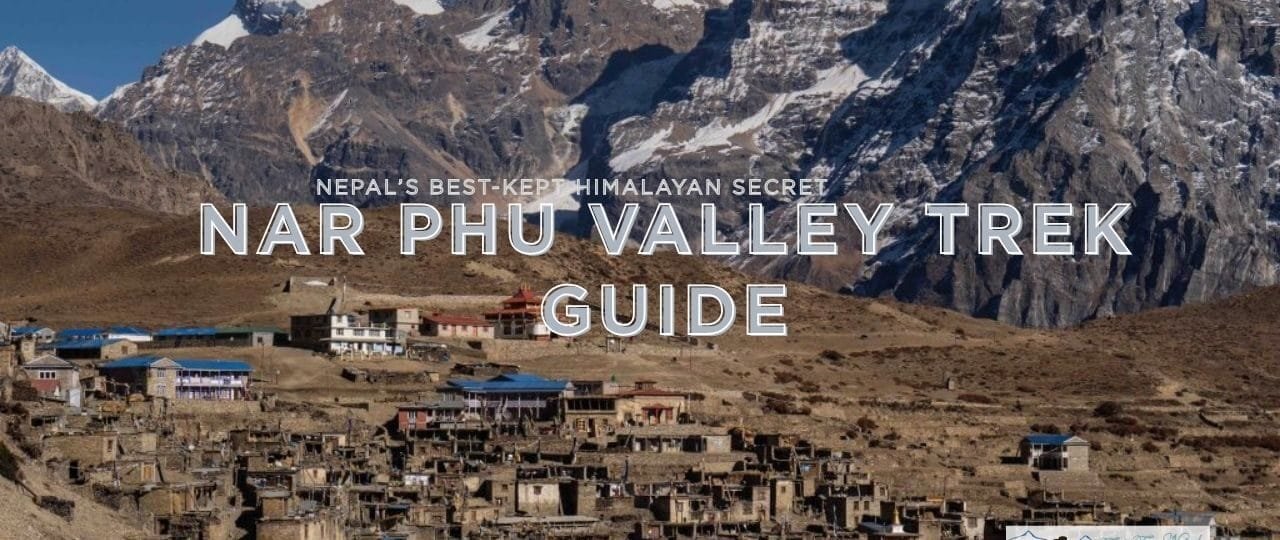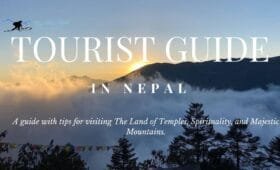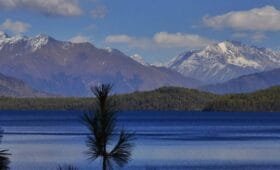The Nar Phu Valley Trek is a rare gem among Nepal’s Himalayan trails, tucked away in the far reaches of the Annapurna region. This secluded trek merges raw mountain landscapes with an authentic Tibetan-influenced culture, making the Nar Phu Valley Trek a captivating adventure for anyone seeking off-the-beaten-path exploration. With ancient villages, chortens decorated with prayer flags, and vantage points for stunning Annapurna and Manaslu vistas, the route feels like stepping into a secluded Himalayan kingdom.
This comprehensive Nar Phu Valley Trek Guide will explore every crucial Nar Phu Valley Trek dimension. We’ll cover the recommended Nar Phu Valley Trek Itinerary, discuss the Nar Phu Valley Trek Cost, route highlights, difficulty, best time to go, and how to integrate philanthropic opportunities via Volunteers Initiative Nepal (ViN). Whether you’re a seasoned trekker hungry for a new challenge or an enthusiast drawn to remote cultural wonders, the Nar Phu Valley Trek welcomes you with a unique synergy of scenic grandeur and living Tibetan-Buddhist heritage.
Introduction
1. Introduction: Why the Nar Phu Valley Trek?
Situated north of the Manang region, the Nar Phu Valley Trek crosses restricted areas bridging the Annapurna and Manaslu massifs. Only opened to foreigners in 2002, this route remains a well-guarded secret, overshadowed by iconic Annapurna Circuit routes. Yet it offers an incomparable sense of isolation: fewer tourists, archaic stone-built villages, pristine yak pastures, and vantage passes exceeding 5,300 meters.
Statistic: According to the Nepal Tourism Board, fewer than 2,000 foreigners annually venture into Nar Phu, compared to the tens of thousands on mainstream Annapurna trails. This exclusivity ensures an authentic, crowd-free trekking experience. Meanwhile, villagers in Nar and Phu maintain centuries-old Tibetan traditions, harvesting barley, and herding yaks amid dramatic Himalayan backdrops.
“The Nar Phu Valley Trek felt like stepping back in time. Yak caravans roam centuries-old trails, and the hospitality was as untouched as the landscapes,”
shares Daniel, a 35-year-old trekker from the UK.
History
2. Cultural & Historical Overview
Nar and Phu are two separate settlements perched at altitudes of ~4,000 meters. Historically, they were trade outposts linking Nepal’s mid-hills with the Tibetan plateau. Their dialect and architecture reflect Tibetan influences. Monasteries dot the area, featuring ancient relics and quietly practicing forms of Tibetan Buddhism. Stacked stone houses and vibrant mani walls confirm how deeply local life ties to spirituality.
Nar and Phu villages rely on seasonal agriculture (barley, potato) and yak herding. Harsh winters see only partial inhabitation as some families descend to lower altitudes. By opening restricted trekking in 2002, the Nepalese government enabled tourism revenue while striving to maintain cultural authenticity. Foreign visitors to Nar Phu must secure restricted permits to preserve this legacy, ensuring mindful tourism fosters local welfare rather than exploitation.
Trek Itinerary
3. Essential Nar Phu Valley Trek Itinerary
Though multiple variations exist, a conventional Nar Phu Valley Trek Itinerary typically spans 9–12 days once you divert from the Annapurna trail near Koto. Below is an indicative 12-day plan from Kathmandu:
Day 1: Kathmandu → Besisahar (~760m) → Koto (~2,600m)
~6–7 hour drive from Kathmandu to Besisahar, plus a ~2–3 hour off-road jeep ride to Koto. Overnight in a local teahouse.
Day 2: Koto → Meta (~3,560m)
Official entry into the restricted area. Steep forested trails cross gorges. ~7 hours of moderate difficulty.
Day 3: Meta → Phu Gaon (~4,080m)
Passing abandoned winter settlements, you climb to the remarkable canyon leading to Phu. ~5–6 hours trek.
Day 4: Rest/Acclimatization in Phu Gaon
Explore Tashi Lhakhang Monastery, which has high vantage points—a day for altitude adaptation.
Day 5: Phu Gaon → Nar Phedi (~3,490m)
Retrace steps and diverge toward Nar. ~5–6 hours. Overnight in a small monastic lodging or teahouse.
Day 6: Nar Phedi → Nar Village (~4,110m)
~3–4 hours up scenic ridges, unveiling the treasured Nar Valley. Subtle farmland and stone dwellings greet you.
Day 7: Nar Village → Kang La Pass (~5,322m) → Ngawal (~3,660m)
It was a highlight day crossing the Kang La pass. ~8 hours, advanced difficulty. Stunning panoramic views of Annapurna II, Gangapurna, etc.
Day 8: Ngawal → Manang (~3,540m)
Join the standard Annapurna route. ~4–5 hours amid scenic farmland, better teahouses. A chance to rest or expand into side hikes.
Day 9: Manang → Chame or Besisahar
Either trek or drive out by jeep, depending on schedules. Some prefer continuing the Annapurna circuit if time allows.
Day 10–12: Return journey
We can explore lower Annapurna enclaves or return to Kathmandu by bus or private jeep.
Nar Phu Valley Trek Duration can condense to ~9 days if you skip rest days or side expansions. Others integrate the Kang La crossing with the entire Annapurna Circuit, extending the route by a week or more.
Trek Cost
4. The Nar Phu Valley Trek Cost
Nar Phu Valley Trek Cost typically surpasses standard Annapurna routes due to restricted area permits and logistical complexities:
- Transport
- Kathmandu → Koto: ~USD 10–15 by bus to Besisahar + jeep hire. Private jeeps can cost ~USD 150–200 if shared among a group.
- Permits
- Nar Phu Valley Trek Permits: ~USD 100 per person/week (Sept–Nov) or ~USD 75 (Dec–Aug). Additional days cost extra.
- Annapurna Conservation Area Permit (ACAP) ~USD 30.
- TIMS Card (~USD 10–20).
- Guide & Porters
- A Nar Phu Valley Trek Guide is mandatory in restricted zones. ~USD 25–30/day. Porters ~USD 15–25/day each.
- Food & Lodging
- Teahouse lodges cost ~USD 3–6 per night at lower altitudes, slightly higher near Nar or Phu. Meals ~ cost USD 5–8 each.
- Higher altitude menus are more expensive, factoring in transport challenges.
- Misc
- Hot shower (~USD 2–5), Wi-Fi (~USD 2–4) if available, charging (~USD 1–2).
- Extended itineraries or side expansions cost more regarding daily staff wages, lodging, etc.
Thus, a 12-day trek might cost ~USD 900–1,300 if you go minimal teahouse style. A Nar Phu Valley Trek Package with an agency typically ~ costs USD 1,500–2,000, incorporating transport, guide/porters, partial meals, restricted permits, etc.
Trek Map
5. Nar Phu Valley Trek Map & Route Explanation
A Nar Phu Valley Trek Map highlights:
- Koto (~2,600m): The entry point from the Annapurna route.
- Meta (~3,560m) & Phu Gaon (~4,080m): Key villages in the upper valley.
- Nar Phedi (~3,490m) & Nar Village (~4,110m): Separated from Phu by rugged canyons.
- Kang La Pass (~5,322m): The crucial high pass bridging Nar to the Annapurna route near Ngawal (~3,660m).
- Manang (~3,540m): The main hub for Annapurna trekkers.
Nar Phu Valley Trek Distance from Koto to Nar/Phu and back through the Kang La pass is ~70–80 km, though expansions or side trips can push that further. The daily ascents revolve around ~500–800m, culminating in the past day near 5,322m. After crossing Kang La, this route merges restricted regions with Annapurna’s standard circuit.
Trek Difficulty
6. Evaluating the Nar Phu Valley Trek Difficulty
Nar Phu Valley Trek Difficulty ranks advanced due to:
- High Pass: Kang La (~5,322m) demands solid acclimatization and stamina.
- Sparse Lodging: In remote Nar, Phu, and Meta, teahouses are minimal and lack robust infrastructure.
- Remoteness: You’ll walk days between significant hubs like Manang or Koto. Access to rescue or re-supply is limited.
- Length: ~9–12 days for the standard route, crossing altitudes over 4,000m multiple times.
Trekkers should have prior multi-day altitude experience or robust cardio. The route’s lower daily foot traffic can add more solitude but fewer “fallback” support points. Hiring an experienced guide remains essential for safety and cultural interpretation.
Best Timing
7. Seasons & Nar Phu Valley Trek Best Time
Nar Phu Valley Trek Weather patterns are akin to the broader Annapurna region:
- Autumn (Sept–Nov)
- Crisp visibility, stable weather, ~20°C in lower altitudes, sub-zero nights above 4,000m. The prime trekking window with minimal precipitation.
- Spring (Mar-May)
- Rhododendron blooms, moderate day temps (~15–20°C near Koto). Some snow might remain at higher passes.
- Winter (Dec–Feb)
- When it is sub-zero across Nar or Phu villages, passes can be impassable. It is only recommended for exceptionally prepared adventurers.
- Monsoon (Jun–Aug)
- Frequent rain in lower altitudes, though Nar-Phu might partially benefit from a rain shadow effect. Still, leeches, muddy trails, and potential landslides hamper comfort.
Nar Phu Valley Trek’s Best Time is autumn for stable passes and clear summits. Spring also charms with flowering hillsides, though some avalanche risk might linger near the pass. Winter sees fewer trekkers but harsh cold, while monsoon dampens visibility.
Trek Permits
8. Permits & Regulations: Nar Phu Valley Trek Permits
Entering Nar Phu mandates:
- Restricted Area Permit
- ~USD 100 per person/week (Sep–Nov), ~USD 75 (Dec–Aug). Additional days cost extra.
- Minimum of 2 trekkers traveling with a licensed agency guide.
- Annapurna Conservation Area Permit (ACAP)
- ~USD 30 for foreigners.
- TIMS Card
- ~USD 10–20.
- Local Checkpoints
- Typically, you show restricted permits at Koto. Keep your passport/visa copies.
These permits preserve the region’s cultural fabric and environment, limiting visitor numbers. If booking a Nar Phu Valley Trek Package, your agency arranges them. Retain them throughout the journey, as rangers or police may request verification near Nar or Phu.
Accommodation
9. Teahouses & Camping: Nar Phu Valley Trek Accommodation
Nar Phu Valley Trek Accommodation combines teahouses and occasional homestays. Key points:
- Meta & Phu Gaon: A handful of teahouses or rudimentary lodges. Basic rooms usually share bathrooms.
- Nar Village: Slightly more teahouse options. Rooms remain minimal, especially in peak season.
- Homestays: Some families open their homes, offering spartan yet warm hospitality.
- Camping: Some groups choose a campsite approach if they are worried about limited teahouse capacity. A guide or cook handles meal prep and gear transport with porters or yaks.
Meals revolve around local staples—dal bhat, Tibetan bread, and noodles. Don’t expect broad Western menus. Above 4,000m, you might face limited or pricier items, factoring in the logistical challenges to re-supply.
FAQs
10. Seven Frequently Asked Questions About Nar Phu Valley Trek
How many days is the Nar Phu Valley Trek Duration?
Typically, it takes 9–12 days once diverging at Koto, plus a buffer for travel from Kathmandu. Some expansions run ~14–16 days if connecting with the Annapurna Circuit.
What is the Nar Phu Valley Trek Difficulty rating?
Challenging. Kang La Pass (~5,322m) plus restricted area conditions require strong fitness and altitude experience.
How much does the Nar Phu Valley Trek Cost?
~USD 900–1,300 for a minimal approach (teahouse style) in ~12 days. A Nar Phu Valley Trek Package might cost ~USD 1,500–2,000, including permits, staff wages, and partial meals.
Which permits are needed?
A restricted permit for Nar-Phu (~USD 100/week in peak season), ACAP (~USD 30), and TIMS (~USD 10–20). You must have at least two trekkers plus a licensed guide.
When is the best time for the Nar Phu Valley Trek?
Autumn (Sept–Nov) or spring (March). Winter is sub-zero, and passes might be blocked by snow. Monsoon sees cloudy skies and muddy trails.
Is a Nar Phu Valley Trek Guide mandatory?
Yes, restricted area rules require a licensed guide. The route’s remoteness also justifies professional assistance.
How do we handle altitude on the trek?
Plan acclimatization days (like in Phu Gaon). Drink plenty of water, ascend slowly, and watch for symptoms of altitude sickness.
Trek Tips
11. Tips & Advice: Nar Phu Valley Trek Tips
11.1 Physical Training & Prep
- Cardio: Running, cycling, or brisk hill walks for ~6 weeks prior.
- Altitude: If possible, complete a shorter 3,000–4,000m trek (like Langtang or Mardi Himal) beforehand to familiarize yourself with altitude adaptation.
11.2 Minimizing Environmental Impact
- Carry Reusable Bottles: Rely on boiled or purified water to avoid single-use plastics.
- Respect Village Customs: Always ask permission before photographing people or religious sites.
- Pack Out Trash: Litter disposal is minimal at high altitudes. You must do your share to keep the region pristine.
11.3 Plan for Emergencies
- Flexibility: Weather or altitude issues might shift your itinerary. Buffer days help.
- Insurance: Ensure high-altitude coverage (~6,000m) for helicopter rescue if necessary.
Trek Route
12. Route Variations & Nar Phu Valley Trek Route Expansions
Nar Phu Valley Trek Route primarily covers Koto → Meta → Phu → Nar → Kang La pass → Ngawal → Manang. Some expansions:
- Combine with Annapurna Circuit
- After crossing Kang La, continue the circuit or ascend to Thorong La (~5,416m). This extends the trek by ~7–10 days.
- Tilmang La
- Another advanced pass bridging with the Manaslu region, though rarely done. High-risk, advanced logistics.
- Shortened Return
- Some might skip Manang, descending earlier to Chame or Besisahar if time is limited.
Nar Phu Valley Trek Distance from Koto to Nar/Phu across Kang La is ~70–80 km. Merging with the entire Annapurna circuit can top 200 km or more. The route’s apex is ~5,322m at Kang La, with around 5–7 hours of hiking daily.
Real-Life Feedback: Nar Phu Valley Trek Reviews
Robin’s Story
Robin, a 31-year-old trekker from the USA, found the Nar Phu Valley Trek “astonishingly quiet.” She recounts:
“We crossed remote canyons and met families living almost medieval lifestyles. The day we summited Kang La pass was surreal—Annapurna’s summits unrolled like a canvas.”
Local Impact
Nar and Phu’s residents highlight that restricted tourism fosters local improvements. Some portion of trekking fees assists local schools or monastery restorations. The route’s minimal traffic ensures personal interactions remain genuine. Indeed, many Nar Phu Valley Trek Reviews rave about heartfelt welcomes, the intangible hush of remote Himalayan enclaves, and the unbeatable thrill of that pass crossing.
Conclusion
From silent canyons to towering passes, the Nar Phu Valley Trek exudes an aura reminiscent of hidden Himalayan kingdoms. The route merges physically demanding trails with living Tibetan-Buddhist enclaves, forging a unique synergy of nature and culture. While overshadowed by the mainstream Annapurna circuit, exploring Nar and Phu confers an authenticity rarely found in more commercial routes.
Make a Double Impact with Volunteers Initiative Nepal
Volunteers Initiative Nepal (ViN) offers philanthropic synergy to your trek. Their charity trekking and travel tours funnel all proceeds to community empowerment, ensuring each step yields a “double impact”:
Share: Encourage friends, families, or social communities to adopt philanthropic trekking and forge sustainable development in remote Himalayan pockets.
Volunteer: Allocate time to local educational, health, or environmental initiatives around the region.
Intern: Tie your academic pursuits (anthropology, sustainable tourism) into on-the-ground research or projects.
Donate: Even modest sums accelerate local schooling, healthcare, or monastery restoration improvements.
Namaste, and may your Nar Phu Valley Trek unify adventure with empathy—carving a future where travelers and local families thrive harmoniously.
Practical Guidance
Extended Practical Guidance & Final Encouragement
1. Seasonal Outline
- Autumn (Sept–Nov): Crisp views, stable passes, peak crowds. Sub-zero nights above 4,500m.
- Spring (Mar-May): Blooming rhododendrons, moderate day temps, possible leftover snow near passes.
- Winter (Dec–Feb): Temperatures are sub-zero across villages, and the Kang La pass is often blocked. It is only feasible for advanced winter trekking.
- Monsoon (Jun–Aug): Fog, rain-lashed trails, and possible landslides. There is a partial rain shadow near Nar/Phu, but muddy approaches hamper comfort.
2. Essential Gear
- Clothing: Layer up with a 4-season sleeping bag, down jacket, windproof shell, gloves, and beanie.
- Footwear: Sturdy boots for rocky terrain, micro-spikes if you suspect snow near Kang La.
- Safety: Bring trekking poles for ascents/descents, a headlamp, and a personal first-aid kit. Carry a reliable tent or use an agency’s gear for partial camping.
3. Handling Altitude
- Slow Gains: If you only have ~9 days, be mindful of the climbs from Meta to Phu/Nar. Insert at least one rest day near ~3,800–4,000m.
- Hydration: ~3 liters daily; watch for headache, insomnia, and dizziness.
- Guide’s Advice: Trust your local guide’s pacing to mitigate altitude sickness risk.
4. Cultural Respect
- Photos: Politely request before capturing people or inside monasteries.
- Monastery Etiquette: Remove shoes and hats; give small donations to support local religious sites.
- Buying Local: Purchase small handicrafts or yak wool items, ensuring direct support to families.
5. Summation
Nar Phu Valley Trek is a bridge between known Annapurna routes and secret Tibetan-influenced enclaves. Distinct from the daily bustle of more popular circuits, Nar and Phu reward those adventurous enough to tackle the route’s altitude, restricted permits, and minimal infrastructure. The payoff is monumental: silent canyons, centuries-old monasteries, intimate cultural exchanges, and an epic pass crossing overshadowed by the Annapurna giants.
Pairing your Nar Phu Valley Trek with Volunteers Initiative Nepal merges personal triumph with local empowerment—ensuring each step fosters your Himalayan dream and the region’s betterment. So step forth: bridging nature’s grandeur with communal synergy, forging a tale of remote discovery that resonates far beyond the boundaries of Nar and Phu.




